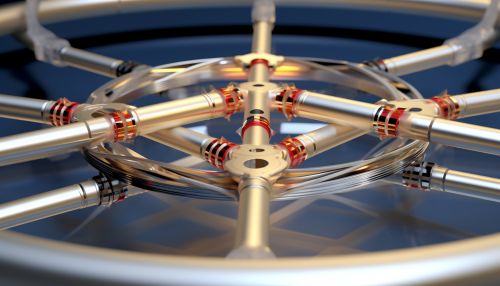Holliday junction
Overview
A Holliday junction is a specialized structure that arises during the process of DNA recombination, particularly during meiosis. Named after its discoverer, Robin Holliday, this four-way DNA junction is a key intermediate in the process of breaking and rejoining of DNA strands, which leads to the exchange of genetic information between homologous chromosomes. This exchange is critical for the generation of genetic diversity, which underlies the process of evolution.
Discovery
Robin Holliday, a British molecular biologist, first proposed the concept of the Holliday junction in 1964. His work was focused on understanding the mechanisms of genetic recombination, and he proposed the Holliday junction as a theoretical model to explain the observed genetic recombination events. It was not until several years later that the existence of Holliday junctions was confirmed experimentally.
Structure
The Holliday junction is a four-way DNA structure that is formed during the process of homologous recombination. It consists of two homologous DNA double helices that are connected at a crossover point. The structure of the Holliday junction is dynamic and can adopt different conformations. The most common conformation is the open square planar structure, where the four DNA strands are approximately 90 degrees apart. However, under certain conditions, the Holliday junction can also adopt a stacked X-structure, where two of the DNA helices are stacked on top of each other.
Formation
The formation of a Holliday junction is a key step in the process of homologous recombination. It begins with the introduction of a double-strand break in one of the DNA molecules. This break is then processed to generate 3'-end single-strand DNA tails. One of these tails invades a homologous DNA molecule, forming a D-loop structure. The invading strand then primes DNA synthesis, extending the D-loop. The second DNA strand from the original molecule can then pair with the extended D-loop, leading to the formation of a Holliday junction.
Resolution
The resolution of the Holliday junction is the final step in the process of homologous recombination. There are two main pathways for the resolution of Holliday junctions: the RuvC-dependent pathway and the Gen1-dependent pathway. In the RuvC-dependent pathway, the RuvABC complex recognizes and binds to the Holliday junction, promoting branch migration and resolution. In the Gen1-dependent pathway, the Gen1 resolvase recognizes and cleaves the Holliday junction, leading to its resolution.
Biological Significance
The Holliday junction plays a critical role in the process of homologous recombination, which is essential for the repair of DNA double-strand breaks, the segregation of homologous chromosomes during meiosis, and the generation of genetic diversity. Defects in the formation or resolution of Holliday junctions can lead to genomic instability, which is a hallmark of many types of cancer.
See Also


